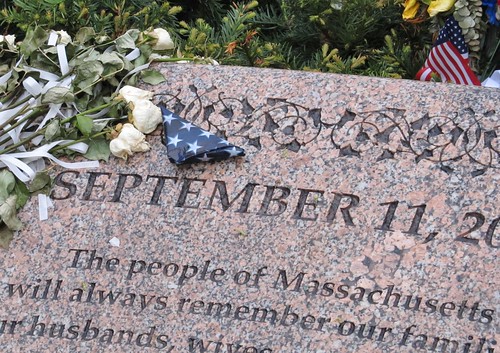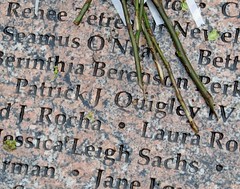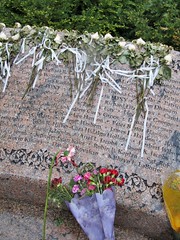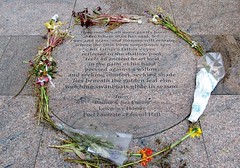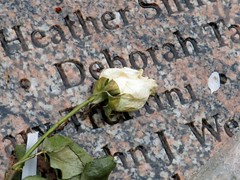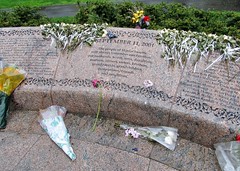Thursday mornings are hectic, as I cross off a laundry-list of chores before heading to Framingham State to teach an 8:30 am class. This morning as I neared Natick on my way to campus, I saw a flag at half-mast and the date dawned. Today, thirteen years ago. The tears came as unbidden and right as rain: tears for the grief, confusion, and fear everyone felt that crisp and beautiful autumn day thirteen years ago, and tears for all the lives that have been lost since then. How many flags at half-mast have flown these past thirteen years?
The spring we put Reggie to sleep, I acquired the habit of weeping during my long drives to and from Keene: 90 uninterrupted minutes each way during which I had nothing to do but steer the car and marshal my own thoughts. My car provided a cocoon of privacy; nobody needed to see or know why I had tears streaming down my face, whether for a person or a pet or for the whole sad and suffering world.
This morning I once again wept in my car: not for any individual person, but for the whole suffering world. I didn’t personally know anyone who was killed on September 11, but that day was a collective wound. Watching the news, hearing the stories, and seeing the flyers posted with pictures of the missing: these were enough to unite us in a shared upwelling of sympathy. When innocent lives are lost, you realize how tenuous and random your own survival is. The people who died on 9/11 and the people who have died in subsequent military operations could easily have been you, me, or any of our loved ones. How can any of us feel safe in a world where some of us are targeted?
Thirteen years is a lifetime, long enough for a child to ripen into puberty. Now that the first generation of post-9/11 children is entering young adulthood, what has happened to our grief and remembrance? They say that time heals all wounds, but memory (as Salvador Dali suggested) is persistent. Thirteen years was a lifetime ago–I was an entirely different person then, leading a life that now seems alien and unknowable. But the simple sight of a flag at half-mast is all it takes to melt the intervening years, the passage of time revealed as illusion. Grief knows no timetable, and sorrow has no season.
We live in an amnesiac culture that ignores the past while chasing the future. In the pursuit of positivity, we are denied the chance to grieve, instead being told to “get over it.” September 11 is one of the few days a year when we are allowed to drop the pretense of optimism and cheer in order to be somber and still. I wish it were more acceptable to grieve whenever the occasion calls for it. To be awake these days is to have one’s heart broken on a daily basis. Planes fall out of the sky, black boys are shot in the street, and journalists are slaughtered overseas. How can we get over the grief of 9/11 when that day was merely the first in a thirteen-year-long litany of loss? At every turn, there is suffering, death, and mayhem; humanity, it turns out, is infinitely inventive when it comes to hurting one another. But with each instance of hurting also comes an instantaneous outpouring of help.
September 11, 2001 was an impossibly beautiful fall day here in New England, an irony that has always struck me as cruel. But perhaps this juxtaposition of tragedy and beauty is merely reflective of the world we live in. In the face of heartbreak, there are hands to help. In the aftermath of suffering comes the strength and resilience to carry on.
I’ve previously blogged these photos of the Garden of Remembrance in Boston’s Public Garden, which I’d shot in May, 2011. In the years since then, this stone memorial is already starting to wear away.
